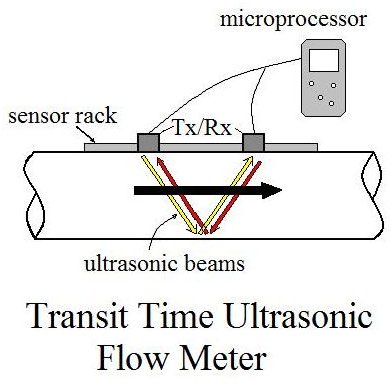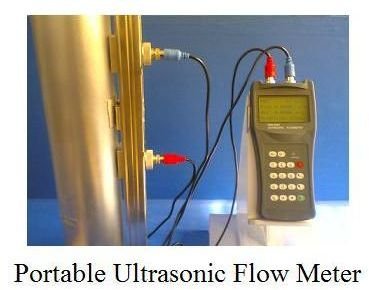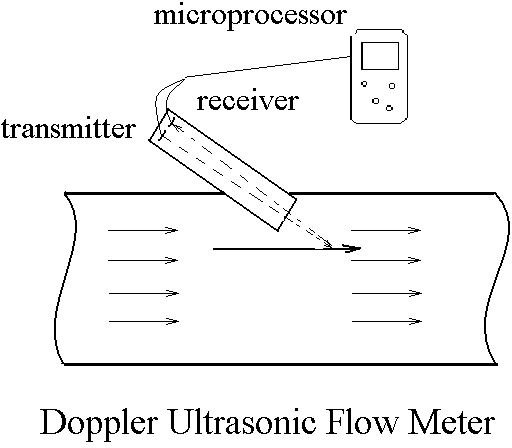Ultrasonic Liquid Portable Flow Meter: Transit Time Meter for Pipes
Introduction
The two types of ultrasonic flow meter are possible alternatives for pipe flow measurement. The transit time ultrasonic flow meter presents an interesting option for pipe flow rate monitoring. A rail mounted meter can be clamped onto an existing pipe without taking the pipe apart to mount the flow meter. Both the doppler ultrasonic flow meter and the transit time ultrasonic flow meter are also available as an insert that mounts in the pipline, much the same as other flow meters, like the magmeter. Both types of ultrasonic flow meter use two ultrasonic transducers that transmit and/or receive ultrasonic waves (frequency > 20 kHz) as part of the process of measuring the pipe flow rate.
Doppler Ultrasonic Flow Meter Principle of Operation
When a doppler ultrasonic flow meter is used for pipe flow measurement, one transducer transmits ultrasonic waves and the other transducer receives ultrasonic waves. The fluid for which pipe flow rate is being measured must have material like particles or entrained air that will reflect ultrasonic waves. The frequency of the transmitted beam of ultrasonic waves will be altered, or shifted, due to being reflected by the air bubbles or particles. The frequency shift, which is proportional to the fluid flow rate through the meter, is measured by the receiving transducer. The receiving transducer can thus generate a signal that is proportional to flow rate. The diagram at the left shows the components of a doppler ultrasonic flow meter schematically.
Time of Transit Ultrasonic Flow Meter Principle of Operation
For a transit time ultrasonic flow meter, both transducers serve alternately as transmitter and receiver of ultrasonic waves. This type of

meter measures the difference in travel time for pulses transmitted against the flow and pulses transmitted in the direction of the flow rate.
The two transducers are mounted on the outside of the pipe so that one is a known distance upstream of the other. A pulse will be transmitted by the downstream transducer, for example, and it will be detected by the

upstream transducer, giving the ’transit time’ for upstream flow. Then the process will be reversed and the upstream transducer will transmit a pulse to be detected by the downstream transducer, to give a ’transit time’ in the direction of flow. A microprocessor is typically used to calculate the pipe flow rate based on the difference between the downstream transit time and the upstream transit time. See the diagram at the right for a schematic diagram of the components of a transit time ultrasonic flow meter.
A unique characteristic of the transit time ultrasonic flow meter is that it can be used for pipe flow measurement without taking the pipe apart. Ultrasonic flow meters are available as rail mounted transducers that can be clamped onto the outside of an existing pipe as shown in the ultrasonic flow meter picture at the left.
Advantages and Disadvantages of an Ultrasonic Flow Meter
Advantages for Both Types of Ultrasonic Flow Meter
- The doppler and transit time ultrasonic flow meter both cause negligible pressure drop when in use for pipe flow measurement.
- The effect of fluid viscosity on pipe flow rate measurement is negligible for both types.
Advantages of the Transit Time Ultrasonic Flow Meter
- The 20:1 turndown ratio for the transit time ultrasonic flow meter is among the highest in comparison with other types of pipe flow meters. This means that an ultrasonic flow meter can accurately measure a pipe flow rate as low as 1/20th of the maximum flow rate.
- A transit time ultrasonic flow meter can be used for pipe flow measurement of both liquids and gases.
Advantages of the Doppler Ultrasonic Flow Meter
- The doppler ultrasonic flow meter can be used to measure the pipe flow rate of dirty liquids and slurries.
Disadvantage of Both Types of Ultrasonic Flow Meter
- Both the doppler and transit time ultrasonic fllow meter have a cost that is relatively high in comparison with other types of pipe flow meter.
Image Credit
Portable Ultrasonic Flow Meter: https://theultrasonicflowmeters.com/liquidultrasonicflowmeters-lowcost.htm
About the Author
Dr. Harlan Bengtson is a registered professional engineer with 30 years of university teaching experience in engineering science and civil engineering. He holds a PhD in Chemical Engineering.
Related Reading
1. Orifice, Venturi, and Flow Nozzle Meters for Measuring Pipe Flow Rate - Differential pressure flow meters, including the orifice meter, venturi meter, and flow nozzle meter, are widely used to measure pipe flow rate. In each case, a constriction in the flow path causes a pressure drop across the meter. That pressure drop can be measured and correlates with flow rate.
2. Pipe Flow Measurement with a Magnetic Flow Meter - The magnetic flow meter is a convenient way to measure pipe flow rate. A magnetic flow meter has no internal parts, so it creates no pressure drop as part of its pipe flow measurement. A magnetic flow meter does have a high cost and power requirement compared to other types of pipe flow meter.
3. Measurement of Pipe Flow Rate with a Rotameter Flow Meter - Values of pipe flow rate are needed for many purposes. Pipe flow measurement can be done with various types of flow meter, including the rotameter, which is covered in this article. The principle of operation and advantages and disadvantages of the rotameter for pipe flow measurement are discussed.
